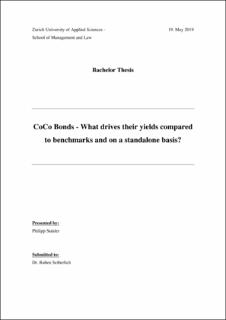Please use this identifier to cite or link to this item:
https://doi.org/10.21256/zhaw-18958| Publication type: | Bachelor thesis |
| Title: | CoCo Bonds - What drives their yields compared to benchmarks and on a standalone basis? |
| Authors: | Stalder, Philipp |
| Advisors / Reviewers: | Seiberlich, Ruben |
| DOI: | 10.21256/zhaw-18958 |
| Extent: | 62 |
| Issue Date: | 2019 |
| Publisher / Ed. Institution: | ZHAW Zürcher Hochschule für Angewandte Wissenschaften |
| Publisher / Ed. Institution: | Winterthur |
| Language: | English |
| Subject (DDC): | 332: Financial economics |
| Abstract: | The need for uniform banking regulations was recognized in the mid nineteen thirties by several countries. The global financial crisis beginning in 2007 was the trigger event for the third and as of today last Basel accord. In 2009 the first draft of Basel III was already submitted, featuring stricter capital rules and marking the first incentive to issue CoCo bonds by the regulator. The combination of a young market and the lack of comparable securities leads to a shortage in statistical evaluations, analysing the drivers of the CoCo market. The high importance of such data is explainable by the big market size and the investors need for transparency, to evaluate potential risks when deciding to invest in CoCo bonds. The drivers of CoCo bonds are analysed over the last 3.5 years and compared to benchmark indices. The impact the factors have will be displayed and discussed for all indicators, macro, market and bond-specific indicators subsequently. It was found that equity markets influence CoCo markets in a strong manner. Specifically, equity indices like EURO STOXX 50 and EURO STOXX banks can explain relevant parts of the variance of the yield. Also, non-bank related indices have an even bigger explanatory factor for yields variance in a single regression analysis. On the other hand, the influence of the single equity price of the issuing banks is rather small, underlining reaction on systemic events and market movements. Stating the influence of equity markets on CoCo bonds, an unexplainable detachment of both markets was detected, which took place over the last six months. Separately, a clear relation between distance to trigger and yields was established with a linear and non-linear model. |
| URI: | https://digitalcollection.zhaw.ch/handle/11475/18958 |
| License (according to publishing contract): | CC BY-NC-ND 4.0: Attribution - Non commercial - No derivatives 4.0 International |
| Departement: | School of Management and Law |
| Appears in collections: | BSc Betriebsökonomie |
Files in This Item:
| File | Description | Size | Format | |
|---|---|---|---|---|
| Bachelor Thesis Philipp Stalder .pdf | 3.41 MB | Adobe PDF |  View/Open |
Show full item record
Stalder, P. (2019). CoCo Bonds - What drives their yields compared to benchmarks and on a standalone basis? [Bachelor’s thesis, ZHAW Zürcher Hochschule für Angewandte Wissenschaften]. https://doi.org/10.21256/zhaw-18958
Stalder, P. (2019) CoCo Bonds - What drives their yields compared to benchmarks and on a standalone basis? Bachelor’s thesis. ZHAW Zürcher Hochschule für Angewandte Wissenschaften. Available at: https://doi.org/10.21256/zhaw-18958.
P. Stalder, “CoCo Bonds - What drives their yields compared to benchmarks and on a standalone basis?,” Bachelor’s thesis, ZHAW Zürcher Hochschule für Angewandte Wissenschaften, Winterthur, 2019. doi: 10.21256/zhaw-18958.
STALDER, Philipp, 2019. CoCo Bonds - What drives their yields compared to benchmarks and on a standalone basis? Bachelor’s thesis. Winterthur: ZHAW Zürcher Hochschule für Angewandte Wissenschaften
Stalder, Philipp. 2019. “CoCo Bonds - What Drives Their Yields Compared to Benchmarks and on a Standalone Basis?” Bachelor’s thesis, Winterthur: ZHAW Zürcher Hochschule für Angewandte Wissenschaften. https://doi.org/10.21256/zhaw-18958.
Stalder, Philipp. CoCo Bonds - What Drives Their Yields Compared to Benchmarks and on a Standalone Basis? ZHAW Zürcher Hochschule für Angewandte Wissenschaften, 2019, https://doi.org/10.21256/zhaw-18958.
Items in DSpace are protected by copyright, with all rights reserved, unless otherwise indicated.